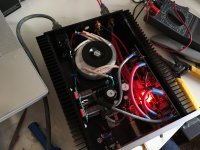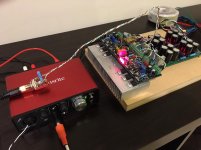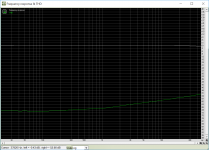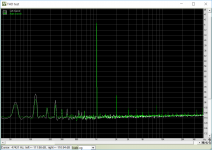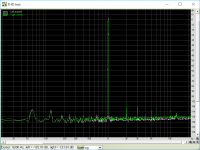Salas, I have a question.
I just got my example up and running. I let it warm up 15 minutes or so without the op-amp and adjusted the offset to as close to zero as I could get it...easy process.
After installing the op-amp, I expected the offset to hover around a millivolt or so.
Instead it drifts from 0V to 3mV or so.
Is that normal?
I got all the matched transistors and NECs from Tea.
It produces sound and quite good sound I might add. I'm only using it as a line stage.
Mine is under 1mv at all times. Floats from .5 to 1mv.
I thought opamp was just a very slow DC offset correction. Music doesn't actually play through it does it? Why would it make a difference in sQ?
I don't know, I could not measure any THD or noise worsening differences between many types except when I put in a TL082. They are used essentially as integrators so they may affect the rest of the spectrum in a filtered manner somehow because that low spec one could increase the 1kHz THD harmonics a little. Gave 6dB more noise floor too. Maybe its output noise interfering in the feedback summing node could do the THD effect also.
Mine is under 1mv at all times. Floats from .5 to 1mv.
That's fine. My older sample was up to 1mV at times but the one I put in lately its one of the two I ordered from Tea and its coming from his GB batch, so I could have a spare and also check them out, is even better as a sample.
Iam using a 10k pot, it's all that I had. Seems to work ok but Iam approaching max on the pot when used with the f5. Gain is 3x. I might need more gain...or really should I be using a 25k pot?
I'll leave the sound impressions for later, let it warm up and break in a little but I will say it's very detailed and the bass is fast and quick. This is not a slow preamp, that's for sure.
I'll leave the sound impressions for later, let it warm up and break in a little but I will say it's very detailed and the bass is fast and quick. This is not a slow preamp, that's for sure.
25K pot is in the range I tested and probably better for sources easy loading while keeping the bandwidth near 1 MHZ. You might be running a near 2MHZ worse case volume setting (at half pot value) preamp right now (!)
*Try 1.5k R6 for 4x gain next time you will be having PCB level access
*Try 1.5k R6 for 4x gain next time you will be having PCB level access
DCSTB voltages unequal
I've hooked up just one DCSTB into the DCG3 and everything looks OK (no smoke!).
The voltage on the single DCSTB I'm using is around 17.2v -/+ with no load so looking good.
However I may have a problem with the other DCSTB though as I connected my trannies to this to check it and the + & - voltages were about 0.4v different with no load. V+ is +17.39v while V- is -16.98v.
I checked components - they all look OK - any thoughts on what I can do or check?
Thanks
I've hooked up just one DCSTB into the DCG3 and everything looks OK (no smoke!).
The voltage on the single DCSTB I'm using is around 17.2v -/+ with no load so looking good.
However I may have a problem with the other DCSTB though as I connected my trannies to this to check it and the + & - voltages were about 0.4v different with no load. V+ is +17.39v while V- is -16.98v.
I checked components - they all look OK - any thoughts on what I can do or check?
Thanks
25K pot is in the range I tested and probably better for sources easy loading while keeping the bandwidth near 1 MHZ. You might be running a near 2MHZ worse case volume setting (at half pot value) preamp right now (!)
*Try 1.5k R6 for 4x gain next time you will be having PCB level access
Thanks Salas. I might try a 25k pot, I'd like to make some sort of shaft extension as well for the pot. I infer if there will be any tonal differences...I can't hear anything bad or anything indicating too much bandwidth or oscillation.
Pcb access is not so good on my build. Changing thebgain resistor means tearing apart the whole chassis. Actually, the math seems to work, I think the f5 clips with 3x gain and I usually use just about every one of the f5'S watts when listening loud (89 db speakers, big room). So it would make sense that the volume control is pretty much maxed out. This is primarily a headphone amp for me, but if it beats my ba-3 I will build another for speaker use.
Iam happy with the heat or lack of heat. I was worried this small chassis wouldn't be enough. I have the amp mosfets and lm regs all bolted to the chassis floor and Iam still able to hold the bottom of the amp in my hands indefinitely. Bottom of chassis is probably 40c or so. The heatsinks probably help although the amp mosfets are not directly bolted to them.
Give me a few days to listen. The amp is full of silmics and they have fooled me before. Also, this amp sounds way better when warm, no doubt.
Attachments
Can you hear any in this chips switch?
In all honesty, I can not tell a difference. I'm currently using a AD712 and everything sounds quite good to my ears.
Bass is especially good.
Let me ask you this...if there's too much offset fluctuation from the op-amp servo, what does that mean?
Also, why is it important to short the inputs when checking it? Offset seems to be about the same on mine whether they're shorted or not.
No hum, no buzz. I can barely hear some noise when vol is max and no source playing but only with sensitive grados.
That sounds pretty quiet to me.
What kind of PS are you using?
I'm just using a trusty ole' Chinese LM317/337 adjustable supply.
In all honesty, I can not tell a difference. I'm currently using a AD712 and everything sounds quite good to my ears.
Bass is especially good.
Let me ask you this...if there's too much offset fluctuation from the op-amp servo, what does that mean?
Also, why is it important to short the inputs when checking it? Offset seems to be about the same on mine whether they're shorted or not.
That's cool you seem to like it
Too much would mean its chasing its own tail (i.e. its own offset). We want it to to behave well, not adding any little artificial near DC frequency.
Not important to short unless there seems to be interference making it too jumpy not letting you null. Its a good practice though.
That's cool you seem to like it
Too much would mean its chasing its own tail (i.e. its own offset). We want it to to behave well, not adding any little artificial near DC frequency.
Yes, I think the sound kicks some serious a_ _! I really wasn't expecting it to sound this good.
I've checked the offset a couple of more times this evening and I'm starting to wonder about what you said about it "chasing its own offset".
The offset is constantly fluctuating from 0V to 1.3mV. It's never a steady reading.
I've checked it with more than one meter and they're all pretty consistent.
Is there any way to fix this?
Listening Impressions
Finally had a chance to listen to this amp now that I know it's working properly. This track is indeed very nice - rich textures and vibrant.
I am listening to my typical test tracks and putting it through its paces. What I am noticing is that it is very dynamic - the range and depth of power is immense. It has super clear highs, no doubt the DC coupled nature of the amp and several MHz bandwidth has something to do with it.
The bass is unbelievable, on some tracks almost overpowering - but I know the response if ruler flat as measured by my setup. Like other reviewers have said, the bass is very "fast" - meaning that it has great articulation on my DT880-250's.
One of the most difficult tracks for a system to reproduce the bass line properly is actually a Suzanne Vega song "Headshots". Many amp/speakers or headamps go mushy here but this amp clearly defines the beats. Deep bass house dance tracks are superb - head shaking/mind blowing pulses of bass on these open back headphones. The triple MOSFET single-ended approach here is really nice at putting up the bass accurately and authoritatively.
Complex orchestral pieces sound great as well with clearly defined instruments. Hans Zimmer's "The Might of Rome" sounds fantastic. The crescendo followed by a softer lull is told in a lush unfolding story like fashion with gripping power yet allowing the nuances of the arrangement to come through.
Live recorded jazz trio ensembles have a naturalness and I can hear the back conversations by the audience and the sound of a fork being placed on a plate or a glass clinking sound elsewhere. The sound of the finger pad on a sax or the finger pad sliding or touching the bass strings can also be heard clearly. Jazz Underground: Live at Smalls - "Everything Happens to Me" and "Kentucky Girl" is a great track to test for detail, percussive attack and directness and transient accuracy. Bela Fleck's "The Secret Drawer" is a great test of percussive detail and dynamic range with varying textures. Check it out here:
https://www.youtube.com/watch?v=mmU8O7REmM4
I have it on FLAC from CD and sounds better than on-line but you get the idea...
Now for one of the most important tests is the female vocal representation. For this I listen to a bunch of tracks by Melody Gardot, Natalie Merchant, Patricia Barber, Anne Bisson, Rebecca Pidgeon, and Norah Jones. They all sound great, and Norah Jones in particular, the natural slight roughness in the texture and timbre of her voice is captured very very well. Anne Bisson's September in Montreal is masterfully reproduced and the drums on that track are captured in their full glory.
Also, absolutely dead silent with music not playing even at full volume, no hiss, no hum audible.
Congratulations Salas - a fine amp indeed. Thank you for the experience and a nifty piece of hardware with some bling that I like to look at as well.
Technical Details: HP x2 Elite with SSDD Win10, Focusrite Solo, tracks are combination of FLAC, AAC, MP3 and FLAC wherever possible, PSU is Antek AS 0515 (50VA 15v) and my own CRLCRC followed by 7815/7915 regulators for each rail, monoblocks.
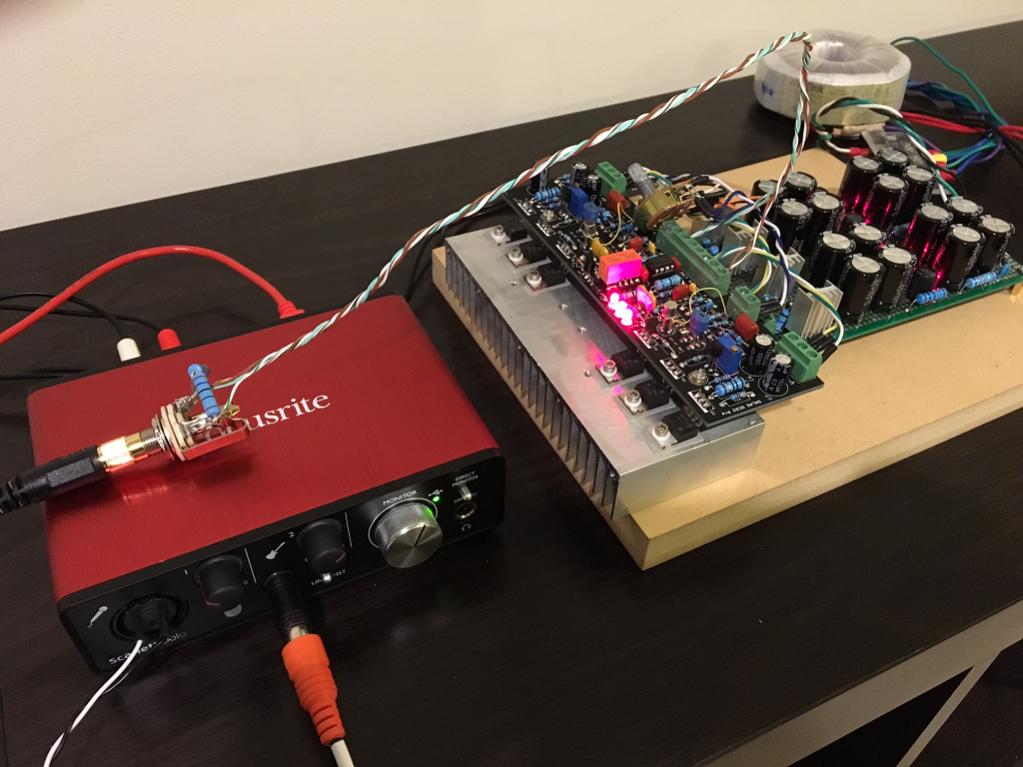
Measured Freq Response:
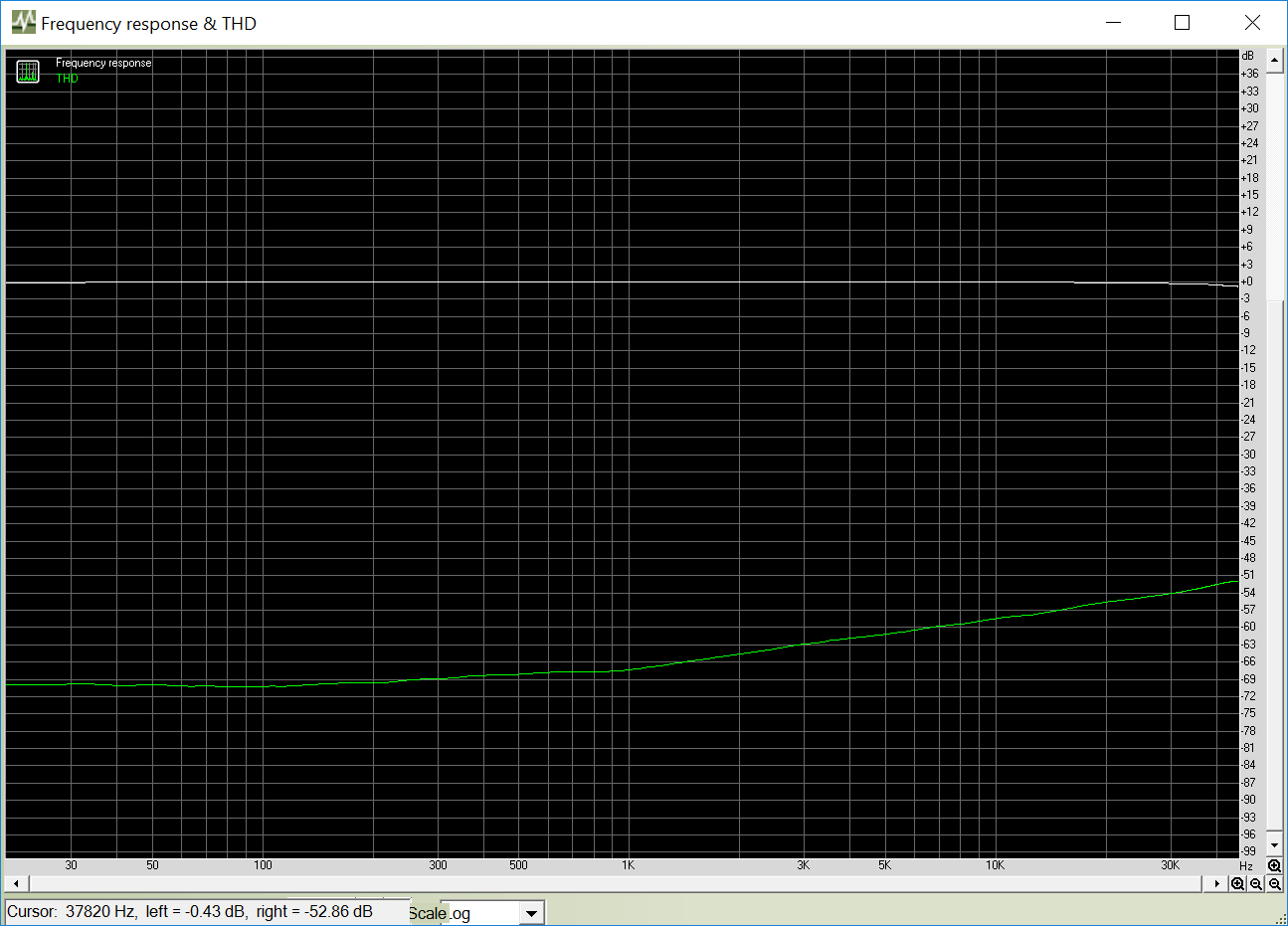
Measured FFT (24bit and 96kHz - but free version of RMAA only allows limited resolution with 51k points):
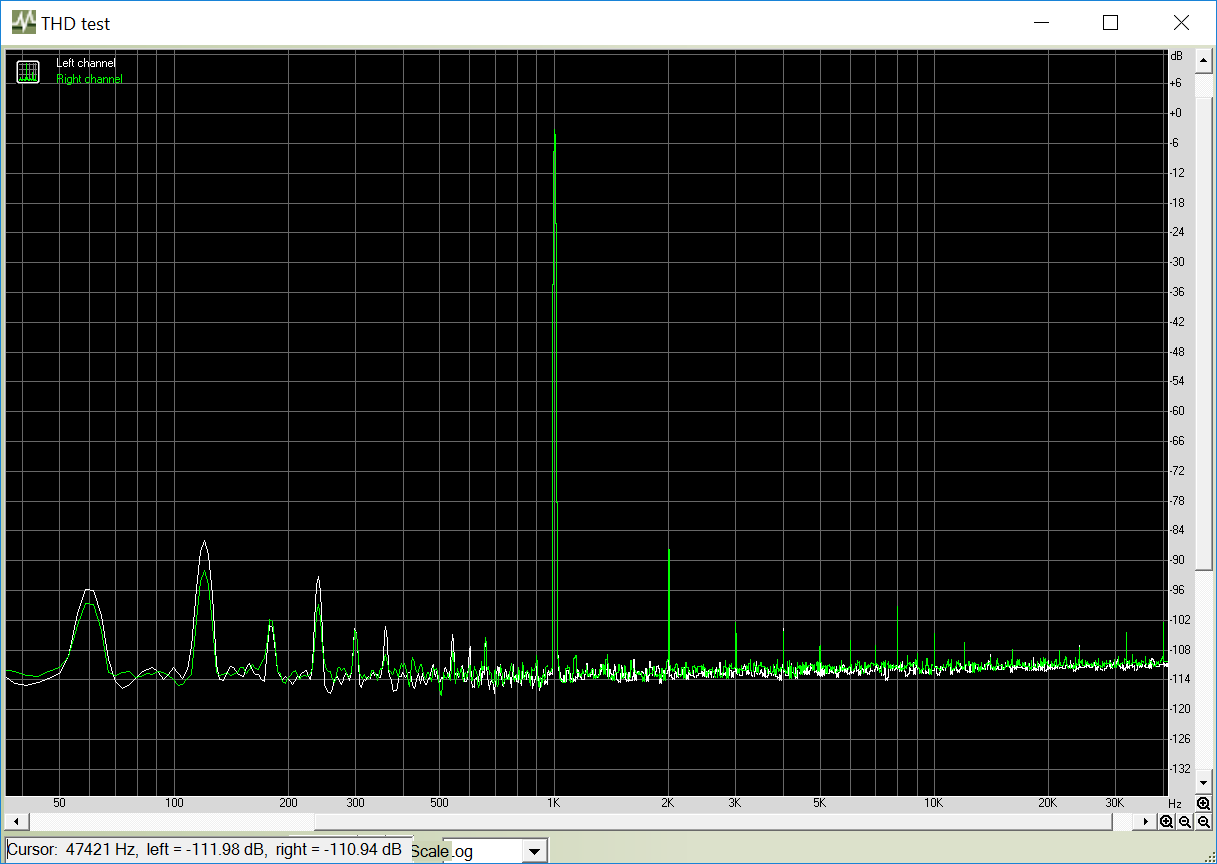
BTW a recording style that becomes the 770 80s is like this one I am listening on right now: https://www.youtube.com/watch?v=qG1U2KRn0RU
Your 880s have less artificial bass oomph because semi open but more linear. Try it though.
Finally had a chance to listen to this amp now that I know it's working properly. This track is indeed very nice - rich textures and vibrant.
I am listening to my typical test tracks and putting it through its paces. What I am noticing is that it is very dynamic - the range and depth of power is immense. It has super clear highs, no doubt the DC coupled nature of the amp and several MHz bandwidth has something to do with it.
The bass is unbelievable, on some tracks almost overpowering - but I know the response if ruler flat as measured by my setup. Like other reviewers have said, the bass is very "fast" - meaning that it has great articulation on my DT880-250's.
One of the most difficult tracks for a system to reproduce the bass line properly is actually a Suzanne Vega song "Headshots". Many amp/speakers or headamps go mushy here but this amp clearly defines the beats. Deep bass house dance tracks are superb - head shaking/mind blowing pulses of bass on these open back headphones. The triple MOSFET single-ended approach here is really nice at putting up the bass accurately and authoritatively.
Complex orchestral pieces sound great as well with clearly defined instruments. Hans Zimmer's "The Might of Rome" sounds fantastic. The crescendo followed by a softer lull is told in a lush unfolding story like fashion with gripping power yet allowing the nuances of the arrangement to come through.
Live recorded jazz trio ensembles have a naturalness and I can hear the back conversations by the audience and the sound of a fork being placed on a plate or a glass clinking sound elsewhere. The sound of the finger pad on a sax or the finger pad sliding or touching the bass strings can also be heard clearly. Jazz Underground: Live at Smalls - "Everything Happens to Me" and "Kentucky Girl" is a great track to test for detail, percussive attack and directness and transient accuracy. Bela Fleck's "The Secret Drawer" is a great test of percussive detail and dynamic range with varying textures. Check it out here:
https://www.youtube.com/watch?v=mmU8O7REmM4
I have it on FLAC from CD and sounds better than on-line but you get the idea...
Now for one of the most important tests is the female vocal representation. For this I listen to a bunch of tracks by Melody Gardot, Natalie Merchant, Patricia Barber, Anne Bisson, Rebecca Pidgeon, and Norah Jones. They all sound great, and Norah Jones in particular, the natural slight roughness in the texture and timbre of her voice is captured very very well. Anne Bisson's September in Montreal is masterfully reproduced and the drums on that track are captured in their full glory.
Also, absolutely dead silent with music not playing even at full volume, no hiss, no hum audible.
Congratulations Salas - a fine amp indeed. Thank you for the experience and a nifty piece of hardware with some bling that I like to look at as well.
Technical Details: HP x2 Elite with SSDD Win10, Focusrite Solo, tracks are combination of FLAC, AAC, MP3 and FLAC wherever possible, PSU is Antek AS 0515 (50VA 15v) and my own CRLCRC followed by 7815/7915 regulators for each rail, monoblocks.

Measured Freq Response:

Measured FFT (24bit and 96kHz - but free version of RMAA only allows limited resolution with 51k points):

Attachments
Last edited:
Focusrite Solo Loopback Test
Here is the loopback test to see what the limits of the self-noise is. This is fully battery powered as my laptop is not plugged in and the Focusrite is powered only via the USB cable. It is picking up 60Hz mains from the house wiring radiation? I have LED lights so no fluorescents to give off EMI. There is a similar harmonic profile as the DCG3 but at much lower level.
Here is the loopback test to see what the limits of the self-noise is. This is fully battery powered as my laptop is not plugged in and the Focusrite is powered only via the USB cable. It is picking up 60Hz mains from the house wiring radiation? I have LED lights so no fluorescents to give off EMI. There is a similar harmonic profile as the DCG3 but at much lower level.
Attachments
Nice to know that you also like it. Hint: There is yet more layering to discover when yours will be fully done too in a grounded metal box, Mogami coax, double mono Tx. Your FFts are far better now than in the start but your testing loop still appears having some lower level interference and residual THD issues even if alone. Some further investigation in software packages and settings, proper loopback inputs impedance, cabling, shielding, grounding, will sort those out eventually. Your DUT maybe is as good as in post#1 but can't fully see it yet through the loop or still bit unfinished at this phase. Could try the plastic cased monolithics also to have another reference. In any case well done up to now. Congrats 

- Home
- Source & Line
- Analog Line Level
- Salas DCG3 preamp (line & headphone)
